Valrene Tweedie OAM (1925~2008)
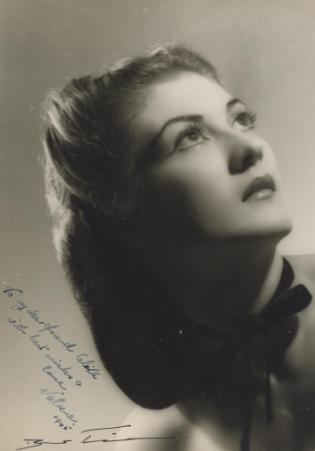
Valrene Tweedie OAM (1925~2008)
21 October 2011 at 23:44
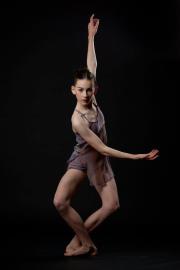 Photo: Sean Murray - www.visionhousecreative.com.au
Photo: Sean Murray - www.visionhousecreative.com.au
CECCHETTI BALLET AUSTRALIA INC. NSW BRANCH
THE VALRENE TWEEDIE SCHOLARSHIP
The Valrene Tweedie scholarship of $5000 will be awarded to a long term NSW Cecchetti student between the age of 16 years and 21 years who has and will in the future represent Cecchetti Ballet in the highest manner.
The scholarship will be awarded for studies within Australia or overseas on a bi annual basis.
The recipient shall proudly conduct themselves with dignity and respect for the Cecchetti heritage and training represented by this award.
The winner of the 2011 Valrene Tweedie Memorial bi-annual Scholarship is BRIDGET MULHOLLAND.
"Although I did not have the opportunity to know Miss Tweedie, I have heard much about her life and career and I think that it is wonderful that this scholarship honours her significant contribution to ballet."
Bridget's Cecchetti achievements:
Honours candidate for Cecchetti Grades 3,4,5,6 Intermediate and Advanced 1.
Dual Gold Medalist for State Junior and Intermediate Medals.
Recipient of the NSW Cecchetti Ballet Country Examination Scholarship.
Bridget was accepted to study full time at The Australian Ballet School in Level 5 from 2011.
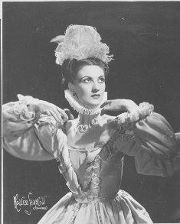 National Library of Australia
National Library of Australia
VALE VALRENE TWEEDIE ~ AUSTRALIA'S 'RUSSIAN' BALLERINA
Australia lost a vital figure in its dance community with the death of Valrene Tweedie in early August 2008 at the age of 83. Tweedie was the only Australian dancer to audition successfully for the Ballets Russes companies that visited Australia between 1936 and 1940. She received her early dance training with Mischa Burlakov, Louise Lightfoot and Leon Kellaway, auditioning for Col. Wassily de Basil and joining his Original Ballet Russe in 1940 at the age of 14. As Irina Lavrova she danced with the company in Australia before leaving for the Americas.
Ballet Russes in Australia, Our Cultural Revolution ~ National Library of Australia
http://www.nla.gov.au/balletsrusses/news.html
http://www.nla.gov.au/balletsrusses/valrene-tweedie-gallery.html
 National Library of Australia
National Library of Australia
Tweedie, Valrene (1925 - 2008) ~ Australia Dancing
Born in Sydney, Valrene Tweedie received her early dance training with Mischa Burlakov, Louise Lightfoot and Leon Kellaway. Her early stage experiences were with the First Australian Ballet and the Polish Australian Ballet.
Tweedie was the only Australian dancer to audition successfully for the Ballets Russes companies that visited Australia between 1936 and 1940. At the age of 14 she auditioned for Colonel de Basil in Sydney and joined his Original Ballet Russe in 1940. As Irina Lavrova she danced with the company in Sydney, Melbourne, Adelaide and Brisbane. She left Australia with the Original Ballet Russe in 1940 and over the succeeding years danced extensively in North and South America with the Ballet Russe de Monte Carlo and Ballet Theatre.
Tweedie returned to Australia in 1952 and in 1953 became third artistic director of the National Theatre Ballet. For the National she staged several ballets with which she was familiar from the de Basil repertoire, including Le Carnaval in which she danced the role of Columbine and on other occasions Chiarina, and Le Coq d'or in which she danced the role of the Queen of Shemakhan. Tweedie also choreographed her own works for the company including Caprice to Prokofiev's Classical Symphony. After the demise of the National Theatre Ballet as a professional company in 1955, Tweedie joined the cast of the Cole Porter musical Can-Can. Subsequently she went on to choreograph for Tivoli revues, to work in educational ballet programs for the National Theatre Movement, and to choreograph for the Elizabethan Opera Ballet Company for which she made her Australian-flavoured Wakooka to a commissioned score from John Antill.
Tweedie began full-time teaching in 1956 working within the Cecchetti system. During her teaching years she also founded Ballet Australia to encourage the creation of new Australian choreography. Her own choreographic works were diverse. In some of her Australian-inspired works Tweedie, influenced by Agnes de Mille and de Mille's efforts to find an American dance idiom, experimented with movement that might express the Australian experience.
Tweedie retired from full-time teaching in 1985 but remained involved with the Cecchetti Society for the rest of her life. She returned to the stage in 1992 as Clara the Elder in the premiere season of Graeme Murphy's Nutcracker for the Australian Ballet. She also appeared in revivals of the work in 1994 and 2000 and was cast by Stephen Baynes in Requiem in 2001 also for the Australian Ballet.
Tweedie was the recipient of a Medal of the Order of Australia in 1991, and an award for lifetime achievement at the 1998 Australian Dance Awards.
Bibliography:
Michelle Potter, 'The fire and the rose', Brolga 29 (December 2008), pp. 11-16.
For more about the early years of Ballet Australia and Tweedie's involvement in it see 'Inspiring mentors: Valrene Tweedie and Laurel Martyn', National Library of Australia News, July 2002.
Read Tweedie's reflections on Massine's Symphonie Fantastique at 'Memories' on the 'Ballets Russes in Australia' website.
Australia Dancing http://www.australiadancing.org/subjects/65.html
 Valrene Tweedie and George Verdak as the leading couple in the Czardas from ‘Raymonda’, Ballet Russe de Monte Carlo (c. 1946)
Valrene Tweedie and George Verdak as the leading couple in the Czardas from ‘Raymonda’, Ballet Russe de Monte Carlo (c. 1946)
Photo: Maurice Seymour Courtesy: Michelle Potter
Michelle Potter on Dancing ~ July 7, 2009
The fire and the rose is a tribute to and obituary for Valrene Tweedie, Australian dancer, teacher and choreographer who died in August 2008. Tweedie danced with Colonel de Basil’s and Sergei Denham’s Ballets Russes companies and with an embryonic National Ballet of Cuba. She choreographed for stage and television in Australia, pioneered dance education programs and founded Ballet Australia in the 1960s to encourage Australian choreography.
The fire and the rose first appeared in Brolga. An Australian journal about dance in December 2008.
http://michellepotter.org/articles/the-fire-and-the-rose
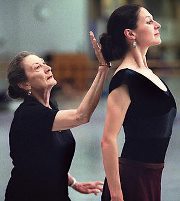 Valrene Tweedie and Miranda Coney in Requiem, 2001, photo by John Woudstra
Valrene Tweedie and Miranda Coney in Requiem, 2001, photo by John Woudstra
Obituaries
Sydney Morning Herald ~ Grand Dame of Australian Dance by Valerie Lawson ~ 7 Aug, 2008
http://www.smh.com.au/news/obituaries/grand-dame-of-australian-dance/2008/08/06/1217702140711.html?page=fullpage#contentSwap1
The Australian ~ Esteemed ballet dancer Valrene Tweedie dies at 83 by Corrie Perkin ~ 6 Aug, 2008
http://www.theaustralian.com.au/news/arts/esteemed-ballet-dancer-dies-at-83/story-e6frg8n6-1111117118794
Media Articles
 Photographer From the collection of Ausdance National
Photographer From the collection of Ausdance National
1998 Lifetime Achievement Award ~ Australian Dance Awards for outstanding achievements in Australian Professional Dance.
Valrene’s performance career began as a very young dancer with Ballets Russes companies, with whom she toured extensively during the 1940s. She later established herself as a highly respected ballet teacher and choreographer. Valrene was the third artistic director of the National Theatre Ballet and, until its demise in 1955, she choreographed, danced in and restaged some of the Ballet Russes repertoire for it. She also choreographed for Tivoli revues and the Elizabethan Opera Ballet Company and worked in educational ballet programs for the National Theatre Movement.
For many decades Valrene was a much-loved teacher in Sydney and became actively involved in the Cecchetti Society. She established Ballet Australia in 1960 to facilitate and encourage the creation of new Australian choreography, and choreographed many diverse works of her own in her efforts to find a movement style expressive of the Australian experience.
http://www.australiandanceawards.net.au/award-winners/1998-australian-dance-awards/valrene-tweedie-oam
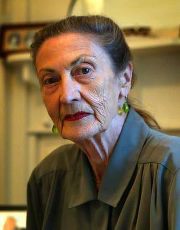 Spotted early ... Valrene Tweedie.
Spotted early ... Valrene Tweedie.
Photo: Sahlan Hayes
Spotted early ... Valrene Tweedie. Photo: Sahlan Hayes
Memories of a Russian doll ~ 15 May, 2006 ~ Arts Reviews Sydney Morning Herald
Valrene Tweedie was only 14 when Colonel Wassily de Basil's Ballets Russes visited Australia in 1939-40. Excited at the prospect of dancing for them, she took to the stage thinking she was having a class. It was, in fact, an audition.
"Now that I look back on it, I suppose they didn't tell us so we wouldn't be nervous," she says.
The young dancer was asked to join the company and travel to the US but her mother, believing she was too young, said no.
Still, the company let her attend rehearsals and occasionally join in. "It was wonderful to have these free classes," says Tweedie, who lives in Sydney. "Then one night, one of the girls sprained her ankle and I was suddenly on. I turned 15 two weeks after that, and [Actors] Equity said it was OK for me to dance if they had an emergency. Well, they had one every day."
Dancing as Irina Lavrova, she performed in Sydney, Melbourne, Adelaide and Brisbane. Her mother eventually relented and she went to America to be part of the Monte Carlo Ballets Russes, staying for 12 years.
Tweedie's memories will flood back tonight at the Cremorne Orpheum for the Australian Ballet's gala screening of the new documentary feature, Ballets Russes. The film, by Americans Daniel Geller and Dayna Goldfine, traces the colourful history of the company established by Sergei Diaghilev in 1909, and was inspired by a 2000 reunion in New Orleans of Ballets Russes dancers, including Tweedie.
Of her American adventure she says: "I was only supposed to go for six months then come home, but I wanted to stay. Then America went into the war and there was no possibility of coming home."
When she did return, Tweedie didn't intend to continue her dance career but soon found she had limited options. "I was so young when I went into the company, I had no training for anything else," she says. "In those days you couldn't go to university as an older student, and there was no government support."
Her saviour was Gertrude Johnson, of the National Theatre Ballet in Melbourne, who in 1953 asked Tweedie to be an artistic director.
"Now that I think about it, I was pretty young to be doing something like that," she says.
She left in 1955 and began full-time teaching the following year, setting up her Australian Academy of Ballet in Sydney, which she ran for 29 years. In 1960 she established Ballet Australia, to encourage new Australian choreography, music and design, and to provide opportunities for new work to be performed.
After a 37-year absence she returned to the stage in 1992 as Clara the Elder in Graeme Murphy's Nutcracker for the Australian Ballet, alternating the role of the ageing Russian ballerina with Dame Margaret Scott. She reprised the role in 1994 and 2000.
"To be quite truthful, it was very scary after so many years," she says. "Once we got the opening night over and got into it, though, it was lovely."
Tweedie turned 81 in March but with her dancer's ramrod-straight back and graceful movements, she looks nowhere near it.
She did not have children: "In my day, and even today, it's not really a suitable career for a family. There's just so much touring, and you spend most of your time in the theatre or rehearsing, so it's really difficult." But the walls of her home are covered with the artwork and loving messages of her five great-nieces and great-nephew.
The youngest, Charlotte, 6, has just started ballet lessons but Tweedie has no plans to teach her. "No, I'll take her to her lessons and leave the rest to her teacher."
http://www.smh.com.au/news/arts/memories-of-a-russian-doll/2006/05/14/1147545204856.html
 Valrene Tweedie, far right.
Valrene Tweedie, far right.
Memories of Symphonie Fantastique by Valrene Tweedie
My first memory of Symphonie Fantastique is seeing it for the first time at the old Theatre Royal in Sydney when de Basil’s Ballets Russes came to Australia in 1938.
How exciting it was, with Irina Baronova as the Beloved and Paul Petroff as the Musician! How we loved them and their performances! I especially loved the second movement with the beautiful white and black ball gowns in front of the deep red backcloths, all designed by Christian Bérard (years before the black and white gowns of My Fair Lady).
We also loved Roman Jasinsky as the Young Shepherd in the third movement and Boris Belsky as the Jailer in the fourth. When I say ‘we’ I am referring to a group of girls from various ballet studios who were lucky enough to be ‘extras’ (walk-ons) in some of the ballets. When not in a performance we were always in the audience. As there were no extras in Symphonie Fantastique we saw it many times from the front.
Watching from the audience I loved the fifth movement, the Witches’ Sabbath. However I was not so fond of that movement in 1940 when I was dancing in it. The girls had to circle the stage from upstage O.P. (right) crawling and twisting from hip to hip, which was not very pleasant.
Symphonie Fantastique was in our permanent repertoire and we performed it frequently in the USA, Canada and Central and South America. It was always well received and very popular.
One particular performance I recall was in 1941 in Cuba. There was a strike in the company (previously unheard of in a ballet company. Ed), and we were missing 18 dancers. It seemed almost impossible to present the advertised ballets. But we had to. So, under the direction of Serge Grigoriev and with his determination that ‘… the show must go on …’, it did. We had a different program every day. We rehearsed each night’s ballets all day, everyone pulling their weight and doubling in roles where necessary. In Symphonie Fantastique’s second movement I was part of one of two couples who appeared first. We came waltzing across the stage, did a lift and a promenade and a few steps. However, on this occasion my partner happened to be one of the strikers, as were both dancers in the other couple, and all the other boys were making quite difficult costume changes. There was no one to partner me so David Lichine, who was dancing the lead role of the Musician, stepped in. At the end of Scene 1 he had to pull off his green jacket, put on a black one, do the little entrance with me and then quickly change jackets again to reappear as the Musician.
What difficult but inspiring days those were!
Ballet Russes in Australia, Our Cultural Revolution ~ National Library of Australia
http://www.nla.gov.au/balletsrusses/Reminiscences-tweedie.html
Valrene Tweedie ~ A gallery
National Library of Australia Archival Photos
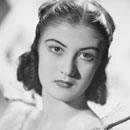

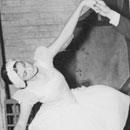
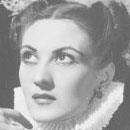




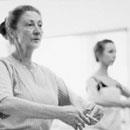
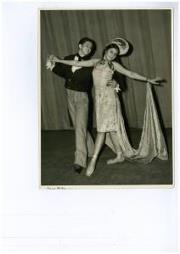 Valrene was born in Sydney in 1925 and began dancing at the Mischa Burlakov and Louise Lightfoot ballet school when she was about 8. Burlakov and Lightfoot also ran a company they called the First Australian Ballet which performed in charity concerts around Sydney in the 1930s. With Bernard Bloch, a son of Jacob Bloch, who founded the dance shoes and dance wear company, Valrene often performed Pavlova’s Gavotte, as pictured here with Bernard, preparing for a performance at the Phillip Park Open Air Theatre in Sydney in about 1937. Two years later, she successfully auditioned for the Original Ballet Russe, the third Ballets Russes company then visiting Australia.
Valrene was born in Sydney in 1925 and began dancing at the Mischa Burlakov and Louise Lightfoot ballet school when she was about 8. Burlakov and Lightfoot also ran a company they called the First Australian Ballet which performed in charity concerts around Sydney in the 1930s. With Bernard Bloch, a son of Jacob Bloch, who founded the dance shoes and dance wear company, Valrene often performed Pavlova’s Gavotte, as pictured here with Bernard, preparing for a performance at the Phillip Park Open Air Theatre in Sydney in about 1937. Two years later, she successfully auditioned for the Original Ballet Russe, the third Ballets Russes company then visiting Australia.
Photo: Mr Blochovitch and Valrene Tweedie, Pavlova’s Gavotte, ca 1937, State Library of NSW, MLMSS 7550, Box 23
THE FIRE AND THE ROSE ~ a tribute to and obituary for
Valrene Tweedie, OAM: 29 March 1925 – 4 August 2008
by MICHELLE POTTER
Valrene Tweedie, who died in Sydney on 4 August 2008, appeared as an extra with the Covent Garden Russian Ballet during its Sydney seasons, 1938–1939. It was the responsibility of company member Edouard Borovansky, who would later go on to establish the Borovansky Ballet in Australia, to hire and rehearse the extras for their appearances. When at the end of that tour Valrene was collecting autographs for her souvenir program, he wrote: ‘To dear Valrene, for memory and example of hard work, Edward Borovansky’.
Tweedie, with the humility that marked her life, always said that her acceptance in 1940 into the Original Ballet Russe, the company that followed the Covent Garden Russian Ballet to Australia, was because she had a good memory and was a quick thinker. In an oral history interview conducted for the National Library of Australia in 1988 she added: ‘I think I had an ability for copying and faking and if the group was going to the right I seemed to be able to manage to go to the right with them’.1 Again with typical humility she never commented on how hard she worked in and for dance, which she did throughout her life, and there are major parts of her career that are still little known to Australians. Her work with Sergei Denham’s company, the Ballet Russe de Monte Carlo (or the ‘One and Only Ballet Russe’), and her work in Cuba are just two areas that await further research. But Borovansky’s words were perceptive and Tweedie’s Australian Dance Award for Lifetime Achievement in 1998 was richly deserved.
The story of Tweedie’s acceptance by Colonel Wassily de Basil into the Original Ballet Russe in Sydney in 1940 and her performances as a member of the company before it left Australia for the United States are well known to the Australian dance world. A series of tiny (8.5 x 6.0 cm) sepia-toned photos of her taken by Melbourne photographer E. A. Rowell document many of the roles she was given. Rowell, Tweedie said, would be backstage and catch her as she headed towards the stage and ask her to pose informally. She would later buy prints from him as a memento of those early experiences. They were also on sale to the public and many found their way into personal albums compiled by fans.
Tweedie left Australia with the Original Ballet Russe in September 1940 aboard the Matson liner the Monterey to begin her career as a professional dancer. Still only 15 and under the guardianship of Nina Verchinina, much admired principal dancer with the company, she was initially overcome by the enormity of what was happening. ‘When the Monterey, the ship we sailed on from Walsh Bay on 20 September 1940, went under the Sydney Harbour Bridge I was so overcome that I wondered what I had done. So I went down to my cabin and I cried my eyes out’, she said in an interview in 1999.2 But despite the initial emotion, she knew she had made the right move: ‘Once I had the opportunity to travel with the de Basil company, I never had any other thought than that was what I’d do for the rest of my life’, she recalled.3
With the de Basil company, she travelled across America and into Canada, toured through South America, and was stranded in Cuba in 1941 during the infamous strike by the de Basil dancers over what was ostensibly an issue concerning salaries. All this time Tweedie was largely dancing the repertoire that Australians had seen between 1936 and 1940.
In 1942, at the British Consulate in Buenos Aires, Tweedie, aged just 17, married fellow de Basil dancer, the Cuban Luis Trapaga. Together they led a peripatetic dancer’s life touring and performing between Cuba and the Americas. As Tweedie’s photo albums indicate, they also enjoyed the friendship of fellow dancers and Trapaga’s extended family and social networks.
It was in Cuba that Tweedie began to teach, a career that she would ultimately pursue in her later life. She taught at the Pro-Arte studios in Havana over two distinct periods, 1944–1946 and 1950–1951. She also worked closely with the Alonso family – Alicia and her husband Fernando and Alberto, Fernando’s brother who had danced in Australia with the de Basil company – as they began their efforts to establish a Cuban national ballet school and company. On programs for the Ballet Alicia Alonso in the 1940s Tweedie is billed as a guest artist, and on programs from the early 1950s for the Alonso’s Ballet Nacional she is billed not only as a dancer but also as régisseur-général, and she is credited with staging a significant proportion of the repertoire. The Cuban experiences both with Pro-Arte and the Alonso family were vital for the direction her life would take when later she returned to Australia. She recalled:
it was a very exciting time and a very formative time for me both in learning to teach and produce and reproduce choreography... I would say that it had a tremendous influence on my life, all that time in Cuba.4
Tweedie had left the de Basil company not long after her marriage and from 1946 to 1950, in between her various Cuban experiences, she danced with Sergei Denham’s Ballet Russe de Monte Carlo, as did Trapaga.
Again they toured across the United States and Canada. In large part, the repertoire of the Ballet Russe de Monte Carlo was quite different from that of the de Basil company, its growth and development having taken a very different path.5 Consequently, Tweedie learnt a new repertoire and came into contact with different choreographers. It was while with the Denham company that Tweedie danced in a series of ballets choreographed by George Balanchine which included Raymonda, Ballet Imperial, Le baiser de la fée, Concerto Barocco, Danses Concertantes and Balustrade. She scored particular success as the lead dancer in the Czardas from Raymonda in which she was partnered by George Verdak.
In Montreal in 1949 one review commented: ‘The Czardas... was led by Valrene Tweedie and George Verdak, who danced with spirit and visualized the exciting gaiety of the Hungarian national rhythms’. Then, during an engagement in Tennessee in 1950, a reviewer wrote: ‘“Czardas” danced by Valrene Tweedie and George Verdak, was dynamic, full of fire and speed and showing again beautiful technique’.6 Tweedie’s admiration for Balanchine remained with her for life and had her visa situation been different she may well have auditioned for Balanchine as he was forming New York City Ballet. In 2004 she recalled:
I didn't have a working permit to stay in America, in the United States. I only had a permit for the length of the contract. So when the contract was up and we had the holidays I had to leave the United States; whether I went to Canada or whether I went to Cuba didn't matter. I was allowed to return only with another contract for whatever it was, nine or ten months or so many weeks. And, when Mr B was forming New York City Ballet, he couldn't offer contracts. He could only offer the season of work, you know, four or five weeks. And a lot of the people who worked with him at that time, they'd have to go on social security or something in between times, so I could not have done that at that time.7
With the Denham company Tweedie was also in contact with choreographers, including Agnes de Mille and Ruth Page, who were working to develop an American dance idiom and vocabulary. She danced in Page’s Frankie and Johnny and in de Mille’s Rodeo, including performing the role of the Rancher’s Daughter in Rodeo to de Mille’s Cow Girl on opening night of the work’s New York season. Her experiences of rehearsing and performing with de Mille would clearly feed into her own Australian works in later years with Ranch House for a National Theatre Ballet workshop in 1955 and Wakooka for the Elizabethan Opera Ballet in 1957.
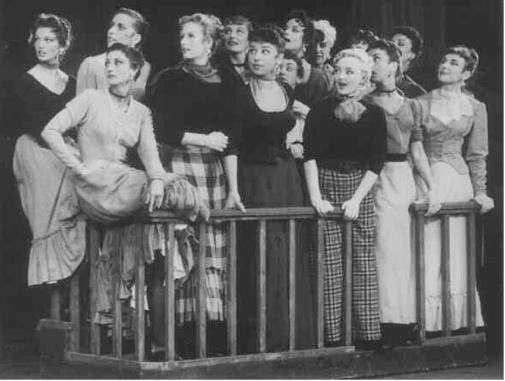
Valrene Tweedie (sitting on the ‘fence’) in the J.C. Williamson production of ‘Can Can’ (1955)
Photographer: unknown Courtesy: Michelle Potter
In 1952 Tweedie returned to Australia and in 1953 became third artistic director of the Melbourne-based National Theatre Ballet. For the National she worked tirelessly to keep the company vibrant and viable – staging several ballets with which she was familiar from the de Basil repertoire, choreographing her own works for the company, establishing a program of workshops and, towards the end of her term as artistic director, developing a schools’ program. But by 1955 the National was in decline as a professional company and Tweedie joined the cast of the Cole Porter musical Can-Can with her American friend from the Denham days, Eleonore Treiber, who had been brought to Australia by the J. C. Williamson organisation to stage the choreography. Treiber danced the leading role of Claudine as well as directing the dances. Tweedie herself played the small speaking part of an artist’s model in addition to dancing in the chorus and, according to the press, performing a can-can 16 times a week!8
Subsequently Tweedie went on to choreograph for Tivoli revues and for the Elizabethan Opera Ballet Company. Her most significant choreographic work, Wakooka, was made for the latter company in 1957. Set on a sheep station ‘somewhere in present day Australia’ as the program note stated, Wakooka was accompanied by a score for two pianos commissioned from John Antill and had designs by Elaine Haxton. In Wakooka Tweedie began to experiment with movement that might express an Australian experience just as Page, de Mille and the Alonso family had worked to find an idiom for their own experiences.
Tweedie returned permanently to her home city of Sydney in 1956 and began full- time teaching, taking over a studio that had been started by Phyllida Cooper, the Australian dancer who performed with the de Basil company as Lydia Couprina, and James Uphaw, an American dancer and, at the time, Cooper’s husband. Tweedie taught her student classes according to the Cecchetti system of training but her studio in Little Regent Street close to Sydney’s Central station was a mecca for professional dancers. By the 1960s, whenever The Australian Ballet was in town for its Sydney season, her 6 pm classes would often be filled by dancers from that company.
Tweedie’s classes were long and demanding. At the barre she would often set what she called ‘Danilova grands battements’, a variation on the standard grand battement in which the leg would return to a cou de pied position instead of fifth. And indeed Tweedie had worked with Alexandra Danilova in the United States when Danilova had been a principal with the Ballet Russe de Monte Carlo. Tweedie’s background in the Cecchetti system meant that centre practice and adage were gruelling. Her classes were, however, especially remarkable for the grand allegro sequences that came at the end of every class. She often said that her penchant for this kind of exercise could be traced back to the fact that throughout her career she had been taught largely by men. They included one of her earliest teachers in Australia, Mischa Burlakov, and the charismatic Russian teachers who taught for the Ballets Russes companies.
In 1960 Tweedie founded Ballet Australia to encourage the creation of new choreography and this small, largely unfunded organisation continued for 17 years to provide an environment for experimentation by Australians working across a variety of dance styles from ballet to jazz, modern to primitive. Her leadership in encouraging broadly based choreographic development in the 1960s and 1970s remains one of her most remarkable achievements. Tweedie was a visionary in this regard and even today her broad outlook has rarely been equalled. She was a facilitator who provided artists with a creative environment in which to experiment and to grow. Ballet Australia gave its first performance on 17 December 1960 at Sydney's Conservatorium of Music. Four works were shown: Tweedie's Overture for Dancers, Ruth Galene's Cantilena, Judith Burgess' Bartok Sonata and Joan Halliday's Sea Interludes. The early seasons were full-scale productions and the period 1961 to 1962 was particularly productive musically. In three seasons, eight dance works were produced, using music by contemporary Australian composers. Six of the eight works were danced to brand new scores commissioned by Ballet Australia from John Antill, Nigel Butterley, Kurt Herweg, Bruce Lawrence, Richard Meale and John Milful.
The organisation was financially unable to maintain its commitment to full-scale productions and by 1964 Ballet Australia performances were presented in the form of choreographic workshops. The first workshop, held on 31 May 1964 at Sydney's Cell Block Theatre, comprised Growing Pains by Ken Mansfield, Concerto Grosso by Keith Bain, Isomorphisms by Judith Burgess, Encounter by Ruth Galene, and The Consuming Flame by Brian Hokin. In 1969 Ballet Australia ran its first choreographic competition, which was won by Nanette Hassall with a work entitled Solus performed to music by Peter Sculthorpe. The choreographic competitions continued during the 1970s and winners in subsequent years were Jeffa Nicholson (If you hold on too tight – it's gone, 1970), Cathryn Short (Movement for Four, 1971), Christine Koltai (Asylum, 1972), Ian Spink (Figurescape, 1973), Arthur Turnbull (Sparesil-nom, 1974) and Ian Spink (Duet, 1976). In 1973 the organisation also ran its first choreographic seminar, which was led by tutors Franz Vervenne from Nederlands Dans Theater, Ray Cook from Australian Dance Theatre and Garth Welch from The Australian Ballet.
Tweedie retired from full-time teaching in 1985 but remained involved with the Cecchetti Society for the rest of her life, teaching frequently at the Society’s annual summer schools. She returned to the stage in 1992 as Clara the Elder in the premiere season of Graeme Murphy's Nutcracker for The Australian Ballet, winning warm praise for the gentle humanity she brought to the role. She also appeared in revivals of the work in 1994 and 2000 and was cast by Stephen Baynes in Requiem in 2001, also for The Australian Ballet. More recently she worked with her colleagues from the early Ballets Russes days, Irina Baronova and Anna Volkova, to stage Les Sylphides for the Australian Ballet.
Valrene Tweedie was my teacher and I danced in some of her productions for Ballet Australia. She was also my friend and I have wonderful memories of sitting up till very late at night and into the morning on more than one occasion in her home in Double Bay, Sydney, each of us with a glass of red wine, talking endlessly about dance. The second last time I saw her she was still speaking in her forthright manner from a bed in the Sacred Heart Hospice in Sydney about the state of dance in Australia, and counting up the number of speeches she had made from the stage of the Cell Block Theatre during the years that Ballet Australia was performing there. Coincidentally, the Cell Block, part of the old Darlinghurst Gaol complex, was directly opposite the hospice.
The last time I saw her it was very close to the end and there were no more words just a wild yet somehow extraordinarily beautiful look in her eyes: ‘The fire and the rose are one.’9
NOTES
1 Valrene Tweedie, oral history interview with Valrene Tweedie conducted by Michelle Potter, 7 November (1988), TRC 2347, National Library of Australia.
2 Valrene Tweedie, interview in The Ballets Russes in Australia 1936–1940: An Avalanche of Dancing, video documentary, National Film and Sound Archive and National Library of Australia (1999).
3 Ibid. 4 Valrene Tweedie, oral history interview with Valrene Tweedie conducted by
Michelle Potter, 7 & 8 December (2004), TRC 5350, National Library of Australia. 5 The history of Denham’s company is the subject of Jack Anderson’s work The one
and only: the Ballet Russe de Monte Carlo (New York: Dance Horizons, 1981). 6 The Montreal Daily Star, 6 April (1949), p. 32; Unidentified newspaper clipping,
Knoxville, Tennessee, February (1950). 7 Valrene Tweedie, oral history interview (2004). 8 ‘They dance can-can 16 times’, Daily Telegraph (Sydney), 10 May (1956), p. 19. 9 T.S Eliot, ‘Little Gidding’, The Four Quartets (1943).
 https://www.facebook.com/photo.php?v=10150603860831250
https://www.facebook.com/photo.php?v=10150603860831250
Enrico Cecchetti Diploma-A practice session with Valrene Tweedie
Filmed at Sydney Dance Company Studio 1995.
This video has been produced for the Cecchetti Society of Australia, NSW Branch.
Its purpose is to provide the NSW Branch with an archival record of Valrene Tweedie and some elements of the Enrico Cecchetti Diploma.
Copyright remains with Reel Communications. If a copy is required please contact the copyright holder.